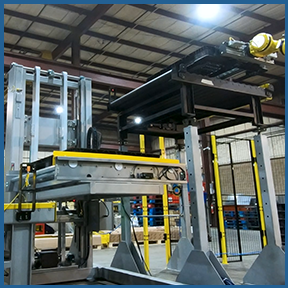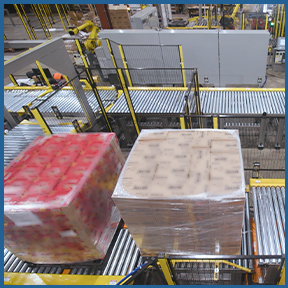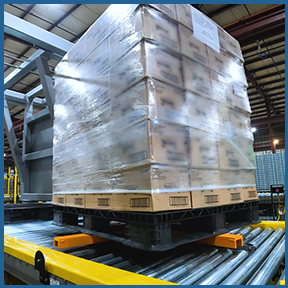Enhancing Robotic Automation: The Role of Load Lifter and Lift & Turn Conveyors in Manufacturing & Distribution

Load lift conveyor raises empty pallets to elevated height for robot to grab and stack.
INTRODUCTION
In the ever-evolving landscape of manufacturing and distribution, robotic automation has become a cornerstone for achieving efficiency and precision at lower costs. Among the myriad of components that make up these advanced systems, load lifter conveyors and lift-and-turn conveyors play important roles. These specialized conveyors enhance robotic systems' capabilities, enabling seamless material handling, increased throughput, lower labor costs, less product damage, and improved safety. Find out more about these types of specialized conveyors on this page.
Back to List of All Conveyor Types
Request Quote ---- JOIN OUR MAILING LIST ---- Contact Us
Load Lifter Conveyors

Example of a section of conveyor that lifts to receive loaded pallets coming in at an elevated height, and then lowers to send it on through the rest of the system.
PURPOSE & FUNCTIONALITY
Load lifter conveyors are ingeniously designed to elevate materials vertically within a facility. They are integral to operations where goods must be moved between different levels or heights. These conveyors, with their adaptability, can handle various load sizes and weights, making them versatile for multiple applications.
HOW THEY WORK
Load lifter conveyors typically consist of a platform or fork mechanism attached to a vertical lifting system. The system can be powered by hydraulic, electric, or pneumatic mechanisms. The conveyor lifts the load to the desired height and either holds it in place for further processing or transfers it to another conveyor or storage area.
APPLICATIONS IN AUTOMATION
- Multi-level Warehouses: Moving pallets or containers to different storage levels.
- Assembly Lines: Elevating parts to various assembly stations.
- Packaging Operations: Lifting products to different packaging lines or machines.
BENEFITS
- Space Efficiency: Maximizes vertical space utilization in facilities.
- Versatility: Can handle a wide range of load sizes and shapes.
- Improved Workflow: Facilitates continuous material flow between different heights.
- Safety: Reduces the need for manual lifting, minimizing the risk of injuries.
Lift & Turn Conveyors

A section is built into the conveyor that raises and reorients the load to proceed through the rest of the system.
PURPOSE & FUNCTIONALITY
Lift and turn conveyors combine vertical lifting with rotational movement, allowing materials to be lifted and then oriented to a specific angle or direction. This dual functionality is essential in processes that require precise positioning of items.
HOW THEY WORK
Lift and turn conveyors use a combination of vertical lift mechanisms and rotating platforms or turntables. Once the load is elevated, the turntable rotates the item to the required position. This operation can be automated and synchronized with other robotic systems for seamless integration.
APPLICATIONS IN AUTOMATION
This type of conveyor is usually used when the loaded pallet needs to be reoriented, usually from either long side forward to short side forward or simply to turn a corner within the system to get to the next station. Here are some specific applications that utilize lift and turn conveyors:
- Robotic Assembly: Positioning components correctly for robotic arms to assemble.
- Inspection and Sorting: Orienting products for visual inspection or sorting processes.
- Packing and Palletizing: Aligning items for efficient packing or stacking on pallets.
BENEFITS
- Precision: Ensures accurate positioning of materials for subsequent processes.
- Enhanced Automation: Integrates seamlessly with robotic systems, enhancing overall automation.
- Flexibility: Adapts to various operational needs, including different angles and positions.
- Efficiency: Streamlines processes that require both lifting and turning, reducing handling time.
Conclusion
Load lifters and lift-and-turn conveyors are pivotal in advancing robotic automation solutions in the manufacturing and distribution industries. These conveyors enhance the capabilities of robotic systems, offering unparalleled precision, efficiency, and versatility. By integrating these advanced conveyors, companies can optimize their operations, improve safety, and achieve higher productivity.
KEY TAKEAWAYS
- Load lifter conveyors maximize vertical space utilization and improve workflow efficiency.
- Lift and turn conveyors offer precise positioning and enhanced automation in complex processes.
- Both types of conveyors integrate seamlessly with robotic systems, providing significant operational benefits.
FUTURE PROSPECTS
As technology advances, integrating load lifters and lift-and-turn conveyors with AI and machine learning will open new possibilities for smarter, more adaptive robotic automation solutions. This evolution will further enhance the efficiency and capabilities of manufacturing and distribution operations, setting new standards for productivity and innovation.
Request Quote ---- JOIN OUR MAILING LIST ---- Contact Us
